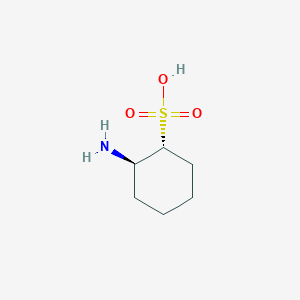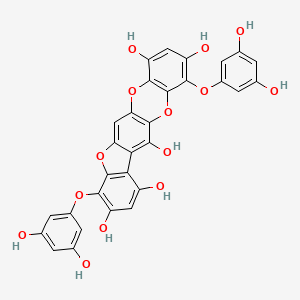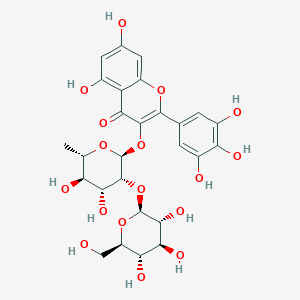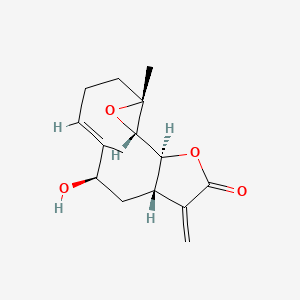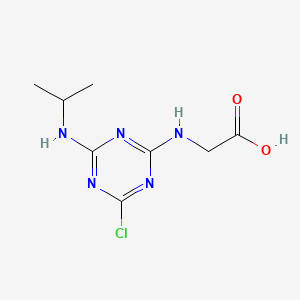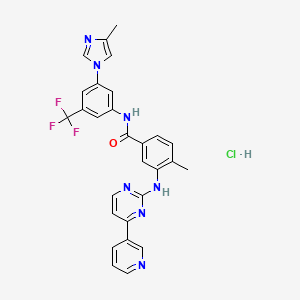
Nilotinib hydrochloride
概述
描述
尼洛替尼盐酸盐是一种主要用于治疗费城染色体阳性的慢性髓性白血病 (CML) 的药物。它是一种第二代酪氨酸激酶抑制剂,旨在克服对伊马替尼(另一种酪氨酸激酶抑制剂)的耐药性。 尼洛替尼盐酸盐以商品名 Tasigna 出售,以其在治疗新诊断的和伊马替尼耐药性 CML 中的疗效而闻名 .
作用机制
尼洛替尼盐酸盐通过抑制费城染色体产生的 BCR-ABL 蛋白的酪氨酸激酶活性发挥作用。它与 BCR-ABL 蛋白的 ATP 结合位点结合,阻止其磷酸化活性。 这种抑制阻断了对白血病细胞存活和增殖至关重要的下游信号通路 .
类似化合物:
伊马替尼: 用于治疗 CML 的第一代酪氨酸激酶抑制剂。尼洛替尼盐酸盐旨在克服对伊马替尼的耐药性。
达沙替尼: 另一种用于治疗 CML 的第二代酪氨酸激酶抑制剂。
波舒替尼: 用于 CML 治疗的第三代酪氨酸激酶抑制剂。
尼洛替尼盐酸盐的独特性: 尼洛替尼盐酸盐与伊马替尼相比,具有更高的效力和对 BCR-ABL 蛋白的特异性,这一点是独一无二的。 它对几种伊马替尼耐药性 BCR-ABL 突变也有效,使其成为对伊马替尼无反应的患者的宝贵选择 .
生化分析
Biochemical Properties
Nilotinib hydrochloride plays a crucial role in biochemical reactions by inhibiting the activity of several tyrosine kinases, including BCR-ABL, c-KIT, and platelet-derived growth factor receptor (PDGFR). It binds to the ATP-binding site of these kinases, preventing their phosphorylation and subsequent activation. This inhibition disrupts the signaling pathways that promote cell proliferation and survival . This compound also interacts with other biomolecules such as EPHA3, EPHA8, DDR1, DDR2, MAPK11, and ZAK, further contributing to its anti-leukemic effects .
Cellular Effects
This compound exerts significant effects on various cell types and cellular processes. In leukemic cells, it inhibits the BCR-ABL kinase, leading to reduced cell proliferation and increased apoptosis. This compound also affects cell signaling pathways, including those mediated by c-KIT and PDGFR, which are involved in cell growth and differentiation . Additionally, this compound influences gene expression and cellular metabolism, contributing to its therapeutic efficacy in CML .
Molecular Mechanism
The molecular mechanism of action of this compound involves its binding to the ATP-binding site of the BCR-ABL kinase, stabilizing its inactive conformation. This binding prevents the phosphorylation of downstream signaling proteins, thereby inhibiting the proliferation of leukemic cells . This compound also inhibits other tyrosine kinases, such as c-KIT and PDGFR, by a similar mechanism, further contributing to its anti-cancer effects .
Temporal Effects in Laboratory Settings
In laboratory settings, the effects of this compound have been observed to change over time. The compound is relatively stable, but its efficacy can decrease due to degradation and the development of resistance in leukemic cells . Long-term studies have shown that continuous exposure to this compound can lead to sustained inhibition of BCR-ABL kinase activity and prolonged survival of treated cells . Resistance mechanisms, such as mutations in the BCR-ABL gene, can reduce its effectiveness over time .
Dosage Effects in Animal Models
In animal models, the effects of this compound vary with different dosages. At therapeutic doses, it effectively inhibits the proliferation of leukemic cells and reduces tumor burden . At higher doses, this compound can cause toxic effects, including hepatotoxicity and cardiotoxicity . Studies have shown that there is a threshold dose above which the adverse effects outweigh the therapeutic benefits .
Metabolic Pathways
This compound is primarily metabolized in the liver through oxidation and hydroxylation, mainly by the enzyme CYP3A4 . The main circulating component in the serum is the parent drug, with its metabolites contributing minimally to its pharmacological activity . The metabolic pathways of this compound involve interactions with various enzymes and cofactors, affecting metabolic flux and metabolite levels .
Transport and Distribution
Within cells and tissues, this compound is transported and distributed through various mechanisms. It is highly protein-bound in the plasma, with a protein binding rate of approximately 98% . The compound is also an inhibitor of the OATP-1B1 transporter, which affects its distribution and accumulation in specific tissues . The distribution coefficient (D) for this compound in n-octanol/0.1 N HCl buffer at 37°C is 0.08, indicating its hydrophilic nature .
Subcellular Localization
This compound is localized within specific subcellular compartments, influencing its activity and function. Studies have shown that it can be internalized by cells and distributed within the cytoplasm and nucleus . The subcellular localization of this compound is crucial for its therapeutic effects, as it needs to reach its target kinases to exert its inhibitory action .
准备方法
合成路线和反应条件: 尼洛替尼盐酸盐的合成涉及多个步骤,从核心结构的制备开始,包括苯甲酰胺衍生物。该过程通常包括以下步骤:
核心结构的形成: 通过使 4-甲基-3-硝基苯甲酸与 4-甲基-1H-咪唑在偶联剂存在下反应来合成核心结构。
还原: 硝基被催化加氢还原为胺,通常使用雷尼镍在甲醇介质中进行.
盐酸盐的形成: 最后一步涉及通过使中间体化合物与盐酸反应将其转化为尼洛替尼盐酸盐.
工业生产方法: 尼洛替尼盐酸盐的工业生产遵循类似的合成路线,但针对大规模生产进行了优化。 该过程确保形成稳定的尼洛替尼盐酸盐晶体形式,这对于其药物制剂至关重要 .
化学反应分析
反应类型: 尼洛替尼盐酸盐经历各种化学反应,包括:
氧化: 尼洛替尼盐酸盐在特定条件下可以被氧化,导致形成降解产物。
还原: 在合成过程中,中间体化合物中的硝基被还原为胺。
取代: 合成涉及取代反应,将官能团引入核心结构。
常见试剂和条件:
催化加氢: 雷尼镍在甲醇中用于还原步骤。
盐酸: 用于形成盐酸盐。
形成的主要产物:
尼洛替尼盐酸盐: 合成形成的主要产物。
降解产物: 在氧化和其他应力条件下形成
科学研究应用
尼洛替尼盐酸盐有几种科学研究应用:
化学: 用作模型化合物来研究酪氨酸激酶抑制剂的合成和稳定性。
生物学: 研究其对细胞信号通路的影响及其抑制其他激酶的潜力。
相似化合物的比较
Imatinib: The first-generation tyrosine kinase inhibitor used to treat CML. Nilotinib hydrochloride was developed to overcome resistance to imatinib.
Dasatinib: Another second-generation tyrosine kinase inhibitor used to treat CML.
Bosutinib: A third-generation tyrosine kinase inhibitor used for CML treatment.
Uniqueness of this compound: this compound is unique due to its higher potency and specificity for the BCR-ABL protein compared to imatinib. It is also effective against several imatinib-resistant BCR-ABL mutations, making it a valuable option for patients who do not respond to imatinib .
属性
IUPAC Name |
4-methyl-N-[3-(4-methylimidazol-1-yl)-5-(trifluoromethyl)phenyl]-3-[(4-pyridin-3-ylpyrimidin-2-yl)amino]benzamide;hydrochloride | |
|---|---|---|
| Source | PubChem | |
| URL | https://pubchem.ncbi.nlm.nih.gov | |
| Description | Data deposited in or computed by PubChem | |
InChI |
InChI=1S/C28H22F3N7O.ClH/c1-17-5-6-19(10-25(17)37-27-33-9-7-24(36-27)20-4-3-8-32-14-20)26(39)35-22-11-21(28(29,30)31)12-23(13-22)38-15-18(2)34-16-38;/h3-16H,1-2H3,(H,35,39)(H,33,36,37);1H | |
| Source | PubChem | |
| URL | https://pubchem.ncbi.nlm.nih.gov | |
| Description | Data deposited in or computed by PubChem | |
InChI Key |
VTGGYCCJUPYZSX-UHFFFAOYSA-N | |
| Source | PubChem | |
| URL | https://pubchem.ncbi.nlm.nih.gov | |
| Description | Data deposited in or computed by PubChem | |
Canonical SMILES |
CC1=C(C=C(C=C1)C(=O)NC2=CC(=CC(=C2)C(F)(F)F)N3C=C(N=C3)C)NC4=NC=CC(=N4)C5=CN=CC=C5.Cl | |
| Source | PubChem | |
| URL | https://pubchem.ncbi.nlm.nih.gov | |
| Description | Data deposited in or computed by PubChem | |
Molecular Formula |
C28H23ClF3N7O | |
| Source | PubChem | |
| URL | https://pubchem.ncbi.nlm.nih.gov | |
| Description | Data deposited in or computed by PubChem | |
DSSTOX Substance ID |
DTXSID60238968 | |
| Record name | Nilotinib hydrochloride anhydrous | |
| Source | EPA DSSTox | |
| URL | https://comptox.epa.gov/dashboard/DTXSID60238968 | |
| Description | DSSTox provides a high quality public chemistry resource for supporting improved predictive toxicology. | |
Molecular Weight |
566.0 g/mol | |
| Source | PubChem | |
| URL | https://pubchem.ncbi.nlm.nih.gov | |
| Description | Data deposited in or computed by PubChem | |
CAS No. |
923288-95-3 | |
| Record name | Nilotinib hydrochloride anhydrous | |
| Source | ChemIDplus | |
| URL | https://pubchem.ncbi.nlm.nih.gov/substance/?source=chemidplus&sourceid=0923288953 | |
| Description | ChemIDplus is a free, web search system that provides access to the structure and nomenclature authority files used for the identification of chemical substances cited in National Library of Medicine (NLM) databases, including the TOXNET system. | |
| Record name | Nilotinib hydrochloride anhydrous | |
| Source | EPA DSSTox | |
| URL | https://comptox.epa.gov/dashboard/DTXSID60238968 | |
| Description | DSSTox provides a high quality public chemistry resource for supporting improved predictive toxicology. | |
| Record name | 4-Methyl-N-[3-(4-methylimidazol-1-yl)-5-(trifluoromethyl)phenyl]-3-[(4-pyridin-3-ylpyrimidin-2-yl)amino]benzamide hydrochloride | |
| Source | European Chemicals Agency (ECHA) | |
| URL | https://echa.europa.eu/information-on-chemicals | |
| Description | The European Chemicals Agency (ECHA) is an agency of the European Union which is the driving force among regulatory authorities in implementing the EU's groundbreaking chemicals legislation for the benefit of human health and the environment as well as for innovation and competitiveness. | |
| Explanation | Use of the information, documents and data from the ECHA website is subject to the terms and conditions of this Legal Notice, and subject to other binding limitations provided for under applicable law, the information, documents and data made available on the ECHA website may be reproduced, distributed and/or used, totally or in part, for non-commercial purposes provided that ECHA is acknowledged as the source: "Source: European Chemicals Agency, http://echa.europa.eu/". Such acknowledgement must be included in each copy of the material. ECHA permits and encourages organisations and individuals to create links to the ECHA website under the following cumulative conditions: Links can only be made to webpages that provide a link to the Legal Notice page. | |
| Record name | NILOTINIB HYDROCHLORIDE ANHYDROUS | |
| Source | FDA Global Substance Registration System (GSRS) | |
| URL | https://gsrs.ncats.nih.gov/ginas/app/beta/substances/K37N7BYX3X | |
| Description | The FDA Global Substance Registration System (GSRS) enables the efficient and accurate exchange of information on what substances are in regulated products. Instead of relying on names, which vary across regulatory domains, countries, and regions, the GSRS knowledge base makes it possible for substances to be defined by standardized, scientific descriptions. | |
| Explanation | Unless otherwise noted, the contents of the FDA website (www.fda.gov), both text and graphics, are not copyrighted. They are in the public domain and may be republished, reprinted and otherwise used freely by anyone without the need to obtain permission from FDA. Credit to the U.S. Food and Drug Administration as the source is appreciated but not required. | |
Synthesis routes and methods I
Procedure details





Synthesis routes and methods II
Procedure details





Synthesis routes and methods III
Procedure details




Retrosynthesis Analysis
AI-Powered Synthesis Planning: Our tool employs the Template_relevance Pistachio, Template_relevance Bkms_metabolic, Template_relevance Pistachio_ringbreaker, Template_relevance Reaxys, Template_relevance Reaxys_biocatalysis model, leveraging a vast database of chemical reactions to predict feasible synthetic routes.
One-Step Synthesis Focus: Specifically designed for one-step synthesis, it provides concise and direct routes for your target compounds, streamlining the synthesis process.
Accurate Predictions: Utilizing the extensive PISTACHIO, BKMS_METABOLIC, PISTACHIO_RINGBREAKER, REAXYS, REAXYS_BIOCATALYSIS database, our tool offers high-accuracy predictions, reflecting the latest in chemical research and data.
Strategy Settings
| Precursor scoring | Relevance Heuristic |
|---|---|
| Min. plausibility | 0.01 |
| Model | Template_relevance |
| Template Set | Pistachio/Bkms_metabolic/Pistachio_ringbreaker/Reaxys/Reaxys_biocatalysis |
| Top-N result to add to graph | 6 |
Feasible Synthetic Routes
体外研究产品的免责声明和信息
请注意,BenchChem 上展示的所有文章和产品信息仅供信息参考。 BenchChem 上可购买的产品专为体外研究设计,这些研究在生物体外进行。体外研究,源自拉丁语 "in glass",涉及在受控实验室环境中使用细胞或组织进行的实验。重要的是要注意,这些产品没有被归类为药物或药品,他们没有得到 FDA 的批准,用于预防、治疗或治愈任何医疗状况、疾病或疾病。我们必须强调,将这些产品以任何形式引入人类或动物的身体都是法律严格禁止的。遵守这些指南对确保研究和实验的法律和道德标准的符合性至关重要。

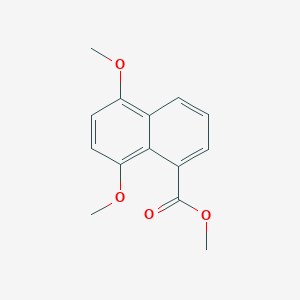
![[2-[4-Hydroxy-3-[(E)-octadec-9-enoyl]oxyoxolan-2-yl]-2-[(E)-octadec-9-enoyl]oxyethyl] (E)-octadec-9-enoate](/img/structure/B1258716.png)

![methyl (2R,3R)-8-methyl-3-(4-methylphenyl)-8-azabicyclo[3.2.1]octane-2-carboxylate](/img/structure/B1258718.png)
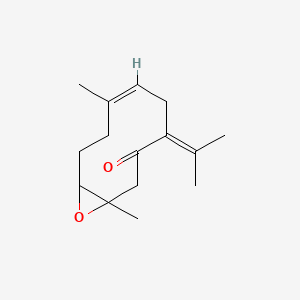
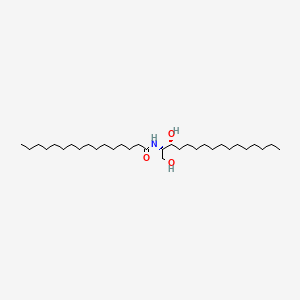
![methyl (4R)-4-[(10S,13R,14R,17R)-4,4,10,13,14-pentamethyl-3,7,11,15-tetraoxo-2,5,6,12,16,17-hexahydro-1H-cyclopenta[a]phenanthren-17-yl]pentanoate](/img/structure/B1258723.png)
![(1aR,7R,7aR,7bS)-1,1,7,7a-tetramethyl-2,3,5,6,7,7b-hexahydro-1aH-cyclopropa[a]naphthalene](/img/structure/B1258724.png)
